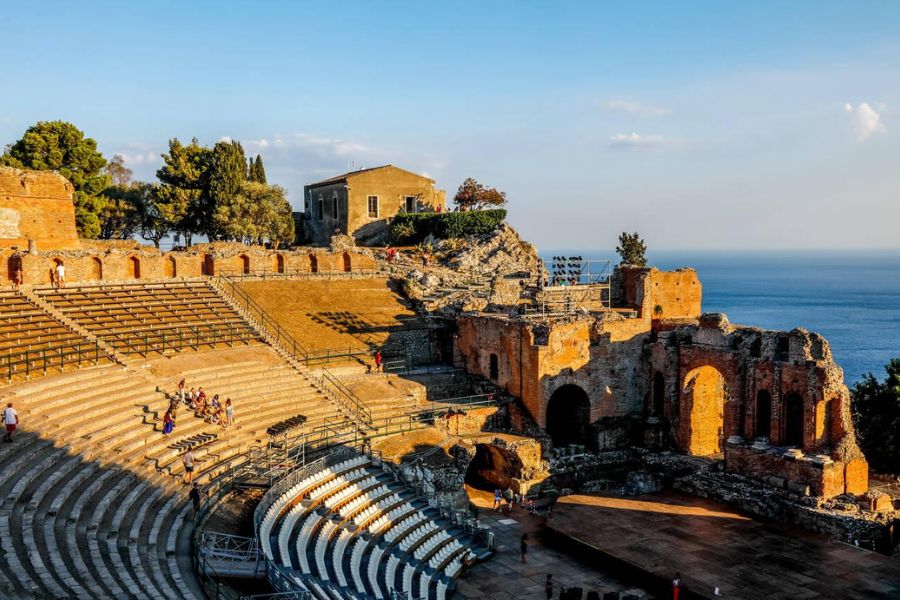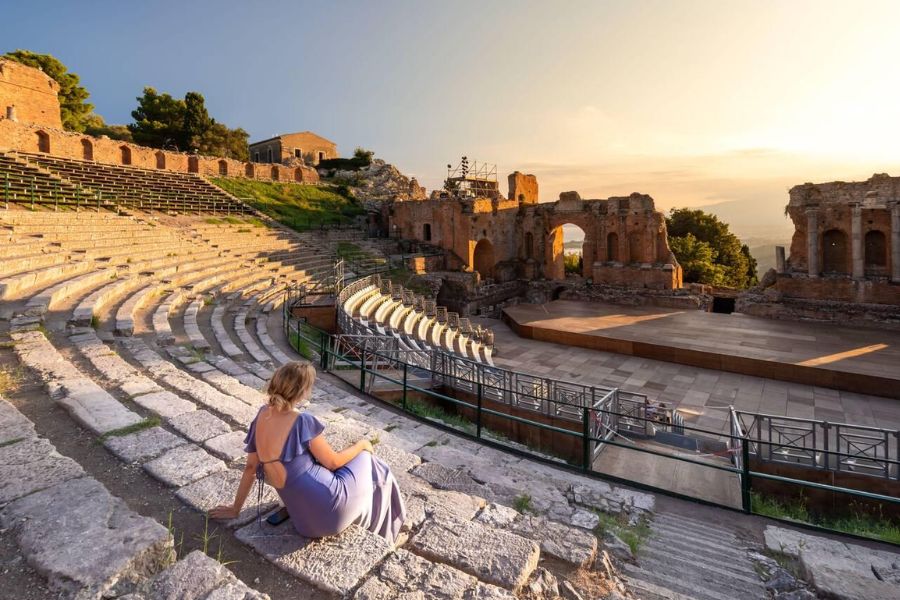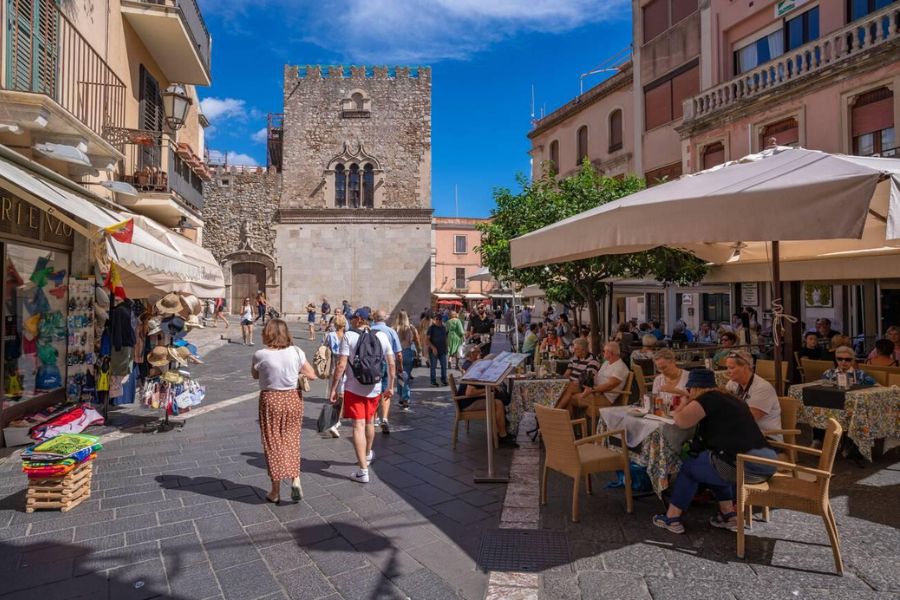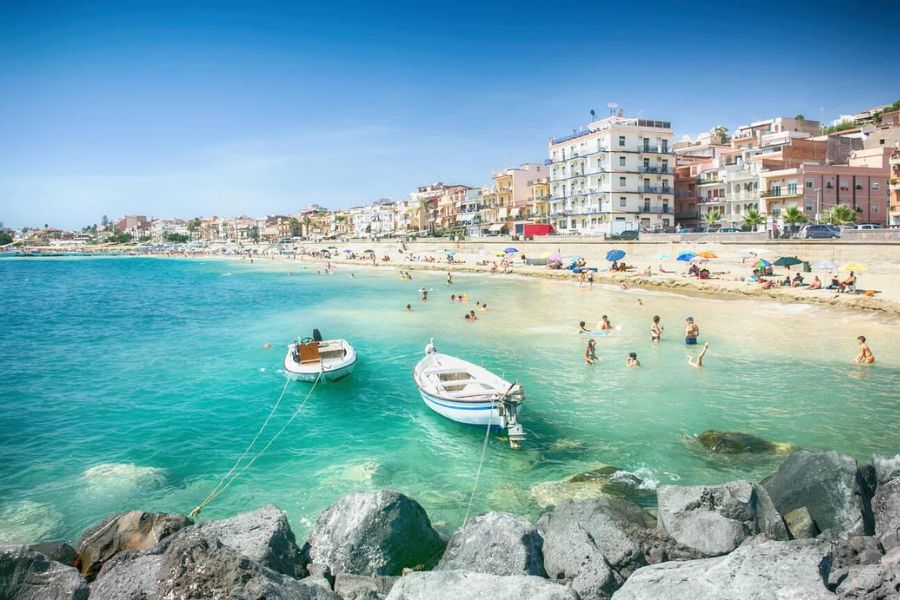Sitting high on a hillside above the sparkling Mediterranean, the Greek Theatre of Taormina is easily Sicily’s most breathtaking ancient monument. I fell in love with this spectacular 3rd-century BC amphitheater the first time I wandered through this charming Sicilian town.
You’ll pay €12 (about $13.50) to enter, and the theater usually opens from 9 a.m. until 4 p.m. or 6:30 p.m., depending on the season.
The theater’s semicircular design perfectly frames Mount Etna and the Ionian coastline—honestly, it might be Sicily’s most photographed view. Walking along the ancient stone corridors, I kept picturing the Greek and Roman crowds who once filled these seats for dramatic shows.
These days, the structure hosts summer concerts, film festivals, and theatrical events, all with that jaw-dropping backdrop.
If you’re planning a visit, try to get there early in the morning or later in the afternoon to dodge the crowds and catch the best light for photos. The golden hour just before sunset turns the stones warm and magical, with the sea and volcano glowing in the distance.

Honestly, this place deserves at least an hour of your time—just wandering and soaking up the history in one of Sicily’s most beautiful spots.
History and Legacy of the Taormina Greek Theater
The Taormina Greek Theater stands as one of Sicily’s most magnificent ancient monuments, with a wild and fascinating history that stretches back more than two thousand years. Its dramatic perch above the Ionian Sea has made it a cultural magnet through Greek times, Roman makeovers, and modern revivals.
Origins in the 3rd Century BCE
Greek builders carved the original theater into Mount Tauro’s hillside in the 3rd century BCE. I’m still amazed at how cleverly they used the natural slope to create excellent acoustics and those spectacular views of the coastline and Mount Etna.
The Greeks designed it mainly for dramatic performances and music. They really focused on how sound carried and how the whole place fit into the landscape.

Walking through the upper tiers, I could almost hear the ancient Greek crowds gathering for tragedies and comedies, with the sea and sky as their backdrop. Back then, the theater was smaller and fit about 5,000 people.
Transition to the Roman Period
When the Romans took over in the 2nd century AD, they gave the theater a serious makeover. Romans expanded it and changed things up to fit their own tastes—think gladiatorial contests and bigger crowds.
They built out the cavea (that’s the seating area) and rebuilt much of the stage. I noticed Roman touches everywhere: columns, decorative flourishes, and a lot more brickwork.
The most obvious Roman changes are the brick perimeter wall and the new stage buildings. Romans also built a maze of corridors and niches under the stage for performers and even animals.
Historical Significance Across Centuries
After the Roman Empire fell, the theater slipped into disuse. Locals scavenged marble and stone for other buildings, but the core structure somehow survived.
By the 18th century, the theater became a must-see for European aristocrats and artists on the Grand Tour. Even Goethe visited and raved about its beauty in 1787.
Since the early 20th century, the theater has hosted performances again. I’ve seen it come alive with international film festivals, classical concerts, and opera. The annual Taormina Arte festival really transforms this place into something magical.

This theater isn’t just about architecture—it’s a symbol of the enduring legacy of classical civilization in Sicily, and it captures the island’s complex multicultural story.
Planning Your Visit: Tickets, Access, and Tours
Visiting Taormina’s Greek Theater takes a little planning if you want the best experience. Here’s what I’ve learned about tickets, tours, and timing so you can make the most of your trip.
Entrance Fee and Ticket Options
The entrance fee for the Ancient Greek Theater of Taormina is €12 per person in 2025. I’d suggest buying tickets online ahead of time through the official Aditus Culture website—lines get long in summer.
Kids under 18 get in free, and EU citizens aged 18-25 pay less. If you’re planning to hit several archaeological sites in Sicily, look into combined tickets that cover multiple attractions.

Special evening events and concerts use a separate ticket system. These nighttime performances are magical but sell out fast, so book weeks ahead if you can.
Guided Tours and Self-Guided Experiences
I’ve tried both guided and self-guided tours. Guided tours usually cost €15-25 extra but are worth it for the historical context and fun facts.
Many companies offer packages that include:
- Transportation from big Sicilian cities
- Skip-the-line entry
- Expert English-speaking guides
- Stops at other Taormina highlights
If you’re going solo, download the Taormina Archaeological Park app for audio commentary and interactive maps. It makes exploring way easier.
You can hire a private guide at the entrance for €60-80 per group. That’s a good deal if you’re with family or friends.
Opening Hours and Visitor Tips
The theater opens daily at 9:00 AM. In summer (April-October), closing time is 7:00 PM; in winter, it’s 4:00 PM. Last entry is always an hour before closing.
I’ve found the best times are early morning (9:00-10:30 AM) or late afternoon (after 4:00 PM). Smaller crowds and soft lighting make for a much better experience—and better photos. Sunsets are stunning but also crowded.
Wear comfy shoes, since you’ll walk on uneven stones and steps. Bring water and sun protection—shade is scarce. Some parts are accessible for visitors with mobility challenges, and you can reach a few viewpoints via alternative paths.

Photography is allowed everywhere, but you’ll need special permission for tripods. There are restrooms and a small café near the entrance.
Experience the Magic: Events and Performances
The Taormina Greek Theater isn’t just a relic—it turns into a vibrant venue for shows throughout the year. The 2025 season promises a mix of performances that really show off the theater’s amazing acoustics and backdrop.
Concerts and Live Theater
I’ve watched several performances here, and honestly, nothing beats seeing a show as the sun sets behind Mount Etna. The Taormina Arte Festival runs every summer, bringing in international musicians, ballet, and opera. The 2025 schedule includes the Sicily Symphony Orchestra and some classic Italian operas.
Local theater groups stage Greek tragedies right where they belong. The productions usually keep the sets minimal, letting the natural scenery steal the show.
Event tickets usually range from €30-120, depending on where you sit and what’s playing. If you want a spot for a big summer concert, book at least two months early.
Highlights of Cultural Events
Every June, the Taormina Film Festival brings movie stars and directors from all over. I was blown away seeing films projected against the ancient stone—talk about atmosphere.
The theater also hosts literary festivals and poetry readings that celebrate Sicily’s cultural roots. Local and international writers often share the stage.

Spring and fall bring themed events focused on Sicilian traditions, wine, and food. Expect plenty of music and dance.
Lighting displays during some events turn the old stones into a glowing spectacle after dark.
Acoustics and Audience Experience
The acoustics here have survived for over 2,000 years. During classical concerts, I could hear every note from the upper seats—no microphones needed.
The venue fits about 5,500 people and you’ll find three main seating options:
- Premium Orchestra – Closest to the stage, best views
- Middle Tier – Great sound, good value
- Upper Gallery – Cheapest, but with panoramic views
You can rent a cushion for €3 (trust me, it helps—the stone seats are hard).
Bring a light jacket, even in summer. The breeze picks up after sunset. Getting there 30-45 minutes early lets you settle in and enjoy the views before the show.
Unforgettable Views: Best Photo Spots
Taormina’s Greek Theater is a dream for photographers. I’ve spent hours here, chasing different angles and lighting, and I’ve got a few favorite spots to share.
Panoramic Views of Mount Etna and the Ionian Sea
The upper section gives you the most jaw-dropping panoramas. I always head for the back row of the cavea for a shot that fits both Mount Etna and the Ionian Sea in one frame.
On clear mornings, you might catch smoke drifting from Etna against a blue sky—it’s worth getting up early for. The contrast between ancient stone and the sweeping landscape is just perfect.

Try the far right or left sides of the upper section for something different. These angles frame the stage with the coastline behind, giving your photos a fresh look.
Capturing the Ancient Stonework
The weathered columns and arches tell a 2,300-year-old story. I love getting close to the stonework, especially in the morning light when shadows play across the surfaces.
You’ll find great architectural shots from the stage area. Focus on the columns against the sky for a classic look that really shows off the theater’s Greek origins.
Don’t skip the corridor entrances (vomitoria). Their arches perfectly frame glimpses of the sea or mountains. These make for cool, layered photos.
A wide-angle lens helps you capture the whole semicircular seating area and really shows off the scale of the place.
Golden Hour and Nighttime Perspectives
Golden hour transforms the theater as the sun drops, turning the stones a warm, amber light. I usually arrive about an hour before sunset to find the best spot.
As the sun sets behind the mountains, the stone glows and shadows stretch, adding drama to your photos.
If you’re lucky enough to visit during a full moon, sometimes the theater opens for evening events. Moonlight on the stones, with Taormina’s lights twinkling below, is pure magic.

During summer festivals, the nighttime lighting gives you a whole new way to capture the history and energy of the place.
Exploring Taormina: Attractions Beyond the Theater
Taormina’s Greek Theater is the main event, but there’s so much more to this Sicilian town. I’ve spent days getting lost in its narrow streets, coastal paths, and historic buildings—there’s magic everywhere.
Isola Bella and Coastal Wonders
You can’t skip Isola Bella while you’re here. This tiny island, connected to the mainland by a narrow beach, gets called “The Pearl of the Ionian Sea” for good reason.
I recommend hiking down from town—the views along the way are unreal.
The clear waters around Isola Bella are perfect for swimming and snorkeling. I spent a whole afternoon exploring underwater rocks and watching colorful fish. The island itself is a nature reserve, with paths and exotic plants.
For the best photos, go early or catch the sunset when the light glows across the water. Plenty of beachside cafés serve up drinks with a view of this little paradise.
Palazzo Corvaja and Historic Landmarks
Palazzo Corvaja stands out as one of Taormina’s most important historical buildings. This place dates all the way back to the 10th century and, honestly, you can feel the layers of history in its walls.
Arab, Norman, and Gothic influences come together in the architecture. I couldn’t help but stare at the intricate stone carvings and wander the peaceful inner courtyard.
These days, the palace hosts the Sicily Tourist Board and a small museum. If you’re curious about local history, you’ll find plenty to dig into.
You should definitely check out the medieval assembly hall on the first floor. The wooden ceiling up there is just stunning.
As I wandered around the historic center, I stumbled upon the ancient Odeon. It’s a smaller Roman theater, and not many tourists seem to notice it.

The town’s medieval walls and gates—especially Porta Messina and Porta Catania—really give you a sense of Taormina’s strategic past. They’re worth a closer look, even if you’re just passing by.
Taormina Cathedral and Piazza Del Duomo
Taormina Cathedral (Duomo di San Nicolò) grabbed my attention right away with its fortress-like exterior. Stepping inside, I found a surprisingly elegant interior.
The cathedral dates back to the 13th century. The rose windows are beautiful, and there’s a baroque fountain right at the entrance.
Piazza del Duomo, the lively square around the cathedral, became my favorite spot for people-watching. I sat at an outdoor café, sipped espresso, and just watched the world go by.
Street performers pop up here throughout the day, adding a bit of energy to the scene. It’s never boring.
Inside the cathedral, you can’t miss the pink marble altars—they’re really striking. There’s also a unique baptismal font from 1522 that caught my eye.
Right in the center of the square, you’ll spot a fountain topped with a centaur, which is actually Taormina’s symbol. It’s a great spot for a photo, if that’s your thing.
Day Trips to Giardini Naxos and Catania
Giardini Naxos sits just a short bus ride from Taormina. If you want a more laid-back beach vibe, this is the spot.
Its long, sandy beaches usually feel less crowded than Taormina’s. I loved grabbing fresh seafood at the waterfront restaurants—there’s just something about eating with your feet in the sand.
Catania, the second-largest city in Sicily, is about an hour away. There’s a certain buzz to the place that you notice right away.
Baroque buildings line the streets, and the city actually earned UNESCO World Heritage status for them. The Cathedral of Sant’Agata really caught my eye, and I couldn’t help but stare at the quirky Elephant Fountain in the main square.

If you swing by Catania, make sure to check out the lively fish market, La Pescheria. Local vendors shout out their catch of the day—swordfish, sea urchins, you name it.
You can also catch a tour to Mount Etna from Catania. Exploring Europe’s most active volcano? Honestly, it’s a wild experience.

